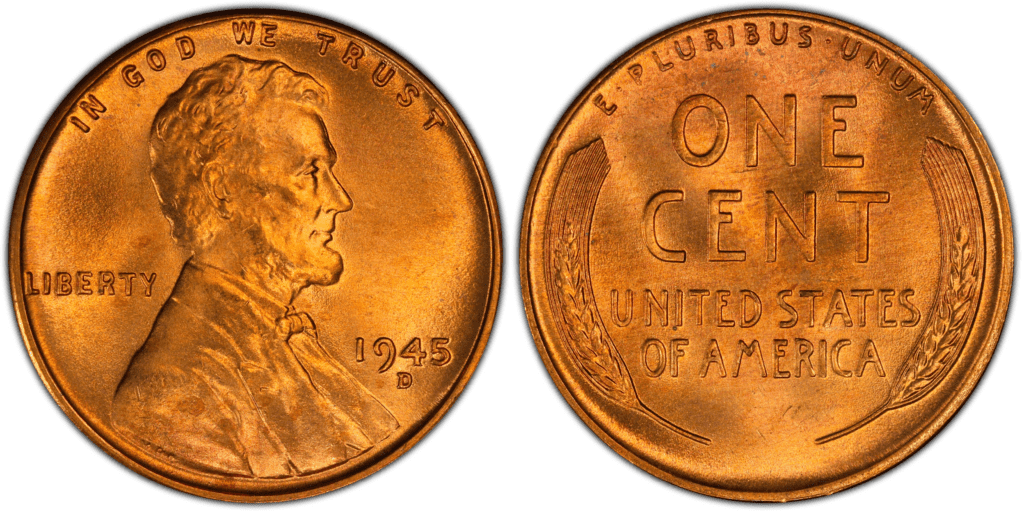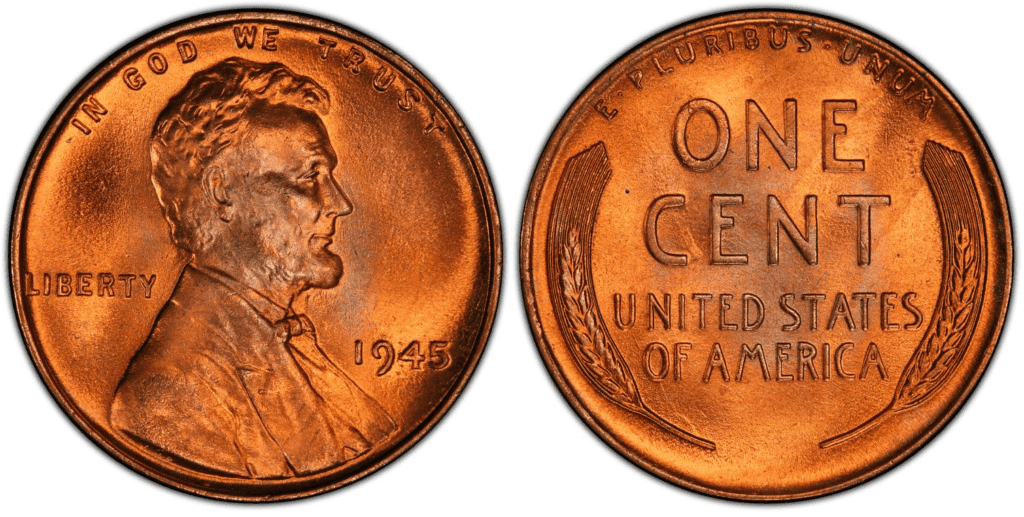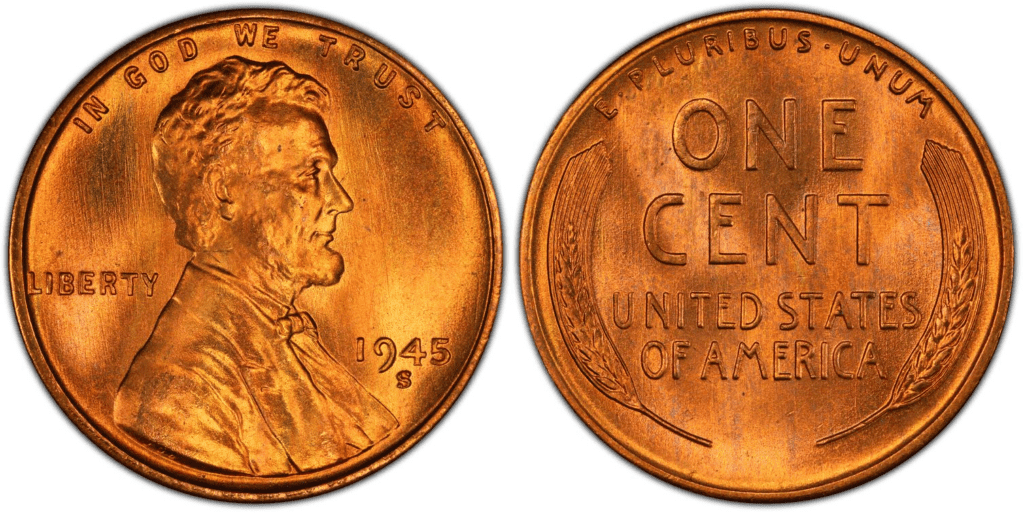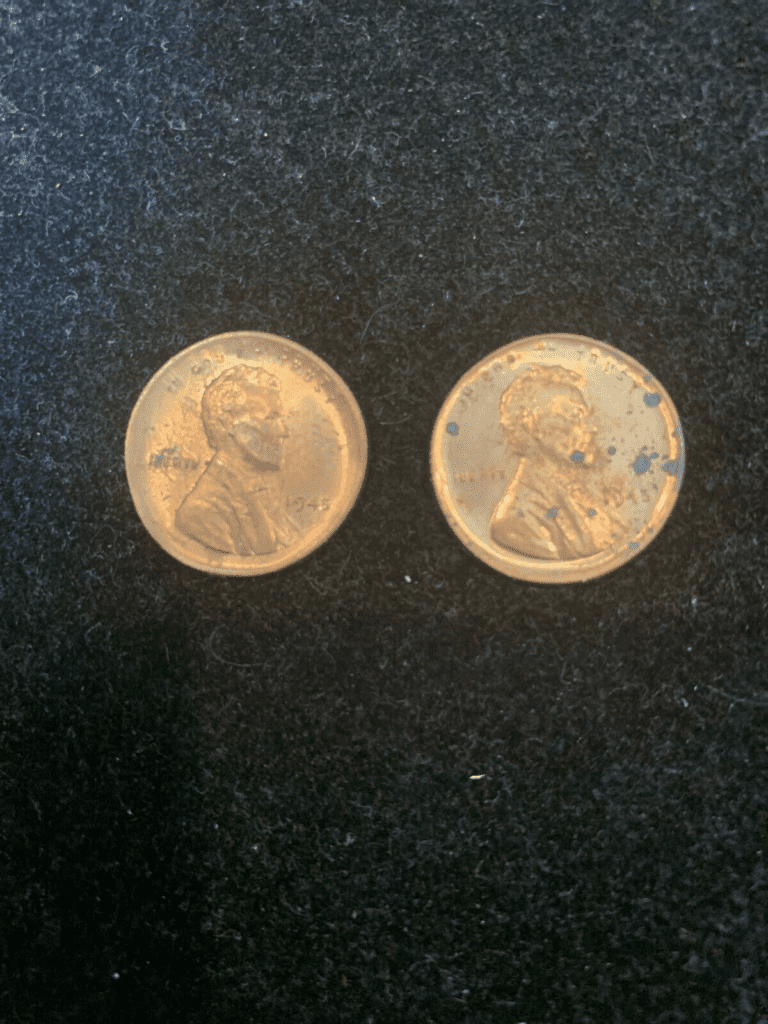What Is the 1945 Lincoln Wheat Penny Made Of?
The Lincoln cent, also known as the Lincoln penny, has a face value of $0.01. The production of this coin began in 1909. The U.S. Mint has struck the Lincoln Penny for over a century and has produced the penny for circulation to this day. In 1945 alone, the Mint made almost 1.5 billion Lincoln Penny.
The 1945 Lincoln Wheat Penny composition is 95 percent copper and 5 percent tin and zinc. The same composition was used for the pennies from 1909 to 1942 and from 1944 to 1982. The U.S. Mint used zinc-plated steel materials for the Lincoln cents produced in 1943, as there were shortages of copper during the war.
Meantime, beginning in 1982 till the present, the Mint used the 97.5 percent zinc and 2.5 percent copper combination for all the Lincoln pennies.
The 1945 wheat pennies were made with a plain edge and a diameter of 19.05 mm. The 1945 Lincoln cent weighed 3.11 grams. The cents made from 1909 to 1982 (,i.e. including the 1951 series) also weighed the same. The wartime steel coins, meantime, weighed 2.7 grams. Currently, the one-cent coins weigh 2.5 grams.

As for the 1945 Lincoln cent design, it’s interesting to know its story. At first, the coin’s design was a flying eagle created by sculptor Augustus Saint-Gaudens, but later on, then-president Theodore Roosevelt learned that by law, an eagle could not appear on the coin. So the coin was decided to be redesigned.
But unfortunately, Saint-Gaudens became very ill and died without finishing the obverse design. So the inception of having Lincoln on the one-cent in 1909 happened when Roosevelt thought of honoring his fellow Republicans, as also was proposed by many citizens to the Treasury Department.
In January 1909, the sculptor Victor David Brenner was commissioned for the coinage redesign to have Lincoln’s profile on the cent. This decision was also because the commemoration of his centennial birth anniversary was also in that same year, as he was born on February 12, 1809.
On the obverse (face) of the 1953 Wheat Penny, you can see the bust of the assassinated 16th U.S. President Abraham Lincoln facing right. You can also find the following inscriptions on this side:
- IN GOD WE TRUST
- LIBERTY
- 1953
On the reverse (tail), Brenner designed two ears of wheat placed on the left and right sides of the coin. You can read the following inscriptions as well:
- E PLURIBUS UNUM
- ONE CENT
- UNITED STATES OF AMERICA
Brenner depicted two stalks of durum wheat in the cent in 1945. This has made the Lincoln cents known as ‘wheat pen,’es’, mainly the coins struck between 1909 and 1958. In 1959, Brenner’s wheat was replaced with the Lincoln Memorial, designed by Frank Gasparro.
1945 Lincoln Wheat Penny Varieties
The 1945 Lincoln Wheat Penny was struck at three Mints in the U.S. in Philadelphia, Denver, and San Francisco. There are three varieties that the 1945 Lincoln Wheat cent is known for, the 1945-D, 1945P, and 1945-S. Apart from these, the mint also produced minted-error coins.
Nearly 1.5 billion 1945 Lincoln cents of the combined varieties were produced for release and circulation.
You can find the details of each variety below:
1945 D Lincoln Wheat Penny
Edge: Plain
Mint Mark: D
Place of minting: Denver
Year of minting: 1945
Face Value: $0.01 (one cent)
Price: $0.50 to $11 (or more)
Quantity produced: 266,268,000
Designer: Victor David Brenner
Composition: 95% Copper and 5% Tin and Zinc
Mass: 3.11 grams
Diameter: 19.05 mm

The 1945 Lincoln cents minted in Denver were abundant in rare kinds out of more than 266 million produced that year. Collectors mostly see that the coins have Extremely Fine grades. Most 1945 pennies are still lightly worn and in better condition.
1945 P Lincoln Wheat Penny
Edge: Plain
Mint Mark: P
Place of minting: Philadelphia
Year of minting: 1945
Face Value: $0.01 (one cent)
Price: $0.50 to $10 (or more)
Quantity produced: 1,040,515,000
Designer: Victor David Brenner
Composition: 95% Copper and 5% Tin and Zinc
Mass: 3.11 grams
Diameter: 19.05 mm

The MS66 condition or higher for the 1945 Lincoln penny series is hard to find nowadays. With very few samples now existing, 5% -10% of the number may have a good quality for MS66 1945-P. In the MS67 condition, there are only about 100 that are believed to be existing.
1945 S Lincoln Wheat Penny
Edge: Plain
Mint Mark: S
Place of minting: San Francisco
Year of minting: 1945
Face Value: $0.01 (one cent)
Price: $0.50 to $22 (or more)
Quantity produced: 181,770,000
Designer: Victor David Brenner
Composition: 95% Copper and 5% Tin and Zinc
Mass: 3.11 grams
Diameter: 19.05 mm

The mint in San Francisco produced less than 182 million coins. This is the fewest of the three varieties of 1945 Lincoln pennies. A few circulated-grade varieties of this coin also had a reasonably inexpensive premium.
List Of 1945 Lincoln Wheat Penny Errors
In 1945, the U.S. Mint struck almost 1.5 billion Lincoln Wheat cents for circulation. Out of this massive production, the equipment used to make coins could have been overworked and deteriorated, which resulted in mint-made error coins.
These errors are primarily unintentional and sometimes are due to human errors. Nevertheless, these error coins show some uniqueness and rarity. Distinct and special coins like these are valuable to many collectors as these are premium ones when sold.
Coins struck with errors during the minting process are, at times, a result of the following:
- Doubled die
- Die crack
- Rotated die
- Clipped planchet
- Bank planchet
- Weak strike
- Off-center strike
- Broadstrike
- Mule
- Lamination flaw
A few samples of the 1945 error coins are listed below:
Lamination Flaw

This 1945 Lincoln Wheat error coin is a result of a lamination flaw. This flaw is a planchet defect due to metal impurities and internal stresses. As a result, the coin will discolor, have an uneven surface, peel, and split.
Clipped planchet

This sample of the 1945 S Lincoln Wheat penny results from a punch that overlapped the leading edge of the metal. Usually, a clipped planchet happens if there’s a misfeed of metal, and it punches strikes’ overlapping holes, leaving the previous strike to produce a curved slip.
Broadstrike

Above is a sample of broadstrike error in 1945 Lincoln Wheat Pennies. Broadstrike error occurs when the circular die that surrounds the lower die (collar die) malfunctions. As a result, the metal of the blank is prevented from flowing outside the confines of the coin. As a result, coins with broadstrike errors usually have plain edges.
How Much Is The 1945 Lincoln Wheat Penny Worth Today?
Coin experts and numismatists put a value on most coins by determining their condition, grade, and rarity. The same way they value the 1945 Lincoln wheat penny. The cent’s melting value is generally based on the value of the metals it is made of: copper, tin, and zinc.
Currently, the value of a 1945 Lincoln wheat cent is approximately $0.0249739. This is based on the price value of the 95% copper and 5% zinc mixture.
Though its face value is almost insignificant, the 1945 Lincoln Wheat cent is still desirable for most collectors. Since these coins are no longer produced, they are rare and have an inherently rising value. Let’s take a look at the table below to see how much it is worth based on its variety:
| Coin | Condition | Grade | Mintage | Value |
| 1945 D Lincoln penny | Circulated/mint | Not graded | 266,268,000 | $0.01 to $0.35 |
| 1945 D Lincoln penny | Uncirculated/mint | MS-66 | 266,268,000 | $13 to $25 |
| 1945 D Lincoln penny | Uncirculated/mint | MS-67 | 266,268,000 | $73 to $228 |
| 1945 D Lincoln penny | Uncirculated/mint | MS-68 | 266,268,000 | $14,100 to $14,400 |
| 1945 P Lincoln penny | Circulated/mint | Not graded | 284,576,000 | $0.01 to $0.35 |
| 1945 P Lincoln penny | Uncirculated/mint | MS-66 | 284,576,000 | $24 to $44 |
| 1945 P Lincoln penny | Uncirculated/mint | MS-67 | 284,576,000 | $84 to $420 |
| 1945 P Lincoln penny | Uncirculated/mint | MS-68 | 284,576,000 | $3,819 to $4,313 |
| 1951 S Lincoln penny | Circulated/mint | Not graded | 136,010,000 | $0.01 to $0.35 |
| 1951 S Lincoln penny | Uncirculated/mint | MS-65 | 136,010,000 | $6 to $52 |
| 1951 S Lincoln penny | Uncirculated/mint | MS-66 | 136,010,000 | $13 to $34 |
| 1951 S Lincoln penny | Uncirculated/mint | MS-67 | 136,010,000 | $51 to $192 |
As you can see, the 1945 penny can be truly valuable. To know its full potential, take a look at these auction records for each variety:
- $14,400 – a 1945-D 1C, RD (Regular Strike) with a grade of MS68RD sold in January 2019 by Heritage Auctions
- $4,465 – a 1945 1C, RD (Regular Strike) coin with a grade of MS67+ sold in April 2015 by Heritage Auctions
- $2,174 – a 1945-S 1C, RD (Regular Strike) coin with a grade of MS67+RD sold in September 2015 by Heritage Auctions
How Does The Grading System Work?
The Sheldon Scale is used by numismatists to provide a numerical value to coins. The Sheldon Scale goes from poor (P-1) to perfect mint state (P-1) (MS-70). Coins were originally evaluated using words to reflect their condition (Good, Fair, Excellent, Etc.). Unfortunately, coin collectors and dealers had different ideas about what each of these terms represent.
Professional numismatists joined together in the 1970s and established CoinGrading standards. These numismatists now assign grades at key places on the seventy-point scale, using the most regularly utilized numeric points in conjunction with the original adjective grade. The following are the most common coin grades:
-
-
- (P-1) Poor – Indistinguishable and probably damaged; if used, must have a date and mintmark; otherwise, rather battered.
- (FR-2) Fair – Nearly smooth, but without the damage that a coin graded Poor often possesses. The coin must have enough detail to be identified.
- (G-4) Fair – Inscriptions have merged into the rims in some areas, and important elements have been mostly erased.
- (VG-8) Very Good- A little weathered, but all of the primary design elements are visible, albeit faintly. There is little if any, central detail left.
- (F-12) Good – The item is very worn, yet the wear is even, and the overall design details stand out clearly. Rims are almost completely isolated from the field.
- (VF-20) Very Fine – Moderately weathered, with some finer features still visible. The motto or all letters of LIBERTY are readable. Both sides of the coin have entire rims that are separated from the field.
- (EF-40) Extremely Fine – Gently used; all gadgets are visible, and the most important ones are bold. The finer details are bold and clear, however, light wear may be seen.
- (AU-50) Uncirculated – Slight evidence of wear on the coin’s design’s high points; may have contact marks; eye appeal should be adequate.
- (AU-58) Uncirculated Choice – Slight traces of wear, no severe contact marks, almost full mint shine, and great eye appeal.
- (MS-60) Mint State Basal – Strictly uncirculated; no indication of wear on the coin’s highest points, but an unsightly coin with reduced luster, visible contact marks, hairlines, and other flaws.
- (MS-63) Mint State Acceptable – Uncirculated, but with contact scratches and nicks, little reduced shine, but otherwise appealing appearance. The strike is weak to average.
- (MS-65) Mint State Choice – Uncirculated with great mint shine, very little contact blemishes, and exceptional eye appeal. The strike is unusually severe.
- (MS-68) Mint State Premium Quality – Uncirculated with superb luster, no obvious contact marks to the naked eye, and exceptional eye appeal. The strike is quick and appealing.
- (MS-69) Almost Perfect Mint State – Uncirculated with perfect brilliance, a sharp and appealing strike, and extremely good eye appeal. A near-perfect coin with minor imperfections in the planchet, strike, and contact markings (seen only under 8x magnification).
- (MS-70) Mint State Perfect – Under 8x magnification, there are no tiny imperfections discernible; the strike is crisp, and the coin is perfectly centered on a beautiful planchet. Rarely seen on a coin, this coin is bright and whole, with original luster and exceptional eye appeal.
-
Where To Buy Or Sell 1945 Lincoln Wheat Penny?
Well, this is not hard to resolve! When buying and selling your 1945 Lincoln Wheat penny, the best place to consider is online. The popular websites you can go to are eBay and Amazon. Some sellers are also offering the coins via Etsy.
If you’re into offline buying and selling, visit physical stores like antique stores and pawnshops. You can also buy and sell your 1945 collections at coin shops and auction houses.
Professionals from PCGS and NGC can also be your consultants if you need advice on how and where to go about buying or selling your 1945 wheat coins.
FAQs
How do I know if my 1945 wheat penny is worth anything?
The overall condition of the coin can determine its worth. So having it professionally graded would help you know whether your 1945 wheat penny is worth a premium or not. Best to consult or bring your penny to professionals like the ones from PCGS or NGC.
Where is the mint mark on a 1945 wheat penny?
There are only two mint marks you can find on a 1945 wheat penny, either a “D” (minted in Denver) or an “S” (minted in San Francisco). You can find these marks below the year of release on the obverse side of the coin.
What are the errors on a 1945 wheat penny?
Out of more than 1.4 billion 1945 wheat coins minted, unintentional error pieces were being produced. These errors are due to, but are not limited to, the following:
- Broadstrike
- Clipped Planchet
- Lamination Flaw
- Doubled Die
- Rotated Die
- Strike-Through
You can search on eBay, Etsy, and Amazon to find some error coins.
